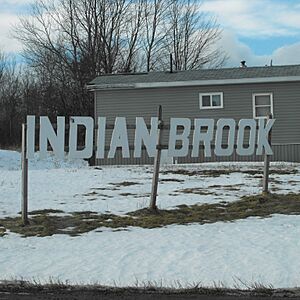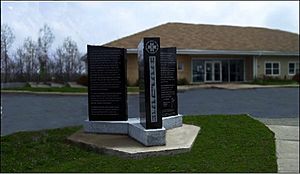Sipekne'katik First Nation facts for kids

The Sipekne'katik First Nation is a group of Mi'kmaq people living in central Nova Scotia, Canada. They have four special areas of land called reserves. As of 2012, about 1,195 Mi'kmaq people lived on these reserves, and around 1,190 lived off them. One of their main communities is Indian Brook 14, Nova Scotia, which is close to Shubenacadie, Nova Scotia. The First Nation used to be called the Shubenacadie First Nation until 2014. They changed their name to Sipekne'katik to use the traditional Mi'kmaq spelling and pronunciation.
Contents
What Does Sipekne'katik Mean?
The name Sipekne’katik comes from the Mi'kmaw language. It means "where the wild potatoes grow." This name shows how important the land and traditional foods are to the Mi'kmaq people.
A Look at Their History

Long ago, in 1699, a French priest named Father Louis-Pierre Thury wanted the Mi'kmaq people in Nova Scotia to live in one settlement near Shubenacadie. Later, during a time called Dummer's War, another missionary, Antoine Gaulin, built a permanent mission there. This mission was next to Snides Lake. He also traveled to other places like Cape Sable to visit Mi'kmaq communities.
The mission in Shubenacadie was dedicated to Saint Anne. Saint Anne is traditionally known as the mother of Mary, making her the grandmother of Jesus. Grandmothers are highly respected in Mi'kmaw society. This shared respect for grandmothers helped the French and Mi'kmaq find common ground, showing how their cultures could connect.
In 1738, Father Jean-Louis Le Loutre arrived at Mission Sainte-Anne. He had spent time learning the Mi'kmaw language. During some wars, like Father Rale's War and King George's War, Mission Sainte-Anne was more than just a church. It was also used as a meeting point for warriors. For example, a group of soldiers passed through here on their way to the Battle of Grand Pré in 1747. Mi'kmaw warriors also used this spot to plan attacks on Halifax and Dartmouth during Father Le Loutre's War.
In 1754, Captain Matthew Floyer visited the mission. He wrote that the church was "the neatest in the Country" with a "Fine lofty Steeple." He also noted that the land around it was good. His map showed three buildings at the mission site.
About a year later, in 1755, the Expulsion of the Acadians began during the French and Indian War. By October 1755, it seems Mission Sainte-Anne was destroyed. Mi'kmaq oral tradition says that the Mi'kmaq people themselves destroyed the mission. They did this to prevent it from being taken by the New Englanders, and they put parts of it into Snides Lake.
The Sipekne'katik reserve was officially created in 1779 by Governor Michael Francklin.
Today, members of the community are involved in discussions about their right to fish. This is part of an ongoing conversation about self-regulated Indigenous fisheries.
Important People from Sipekne'katik
- Daniel N. Paul - A respected Mi'kmaq elder, author, and activist.
- Jean-Baptiste Cope - A leader of the Mi'kmaq militia in the past.
- Jean-Louis Le Loutre - A missionary priest who worked with the Mi'kmaq.
- Cathy Elliott - An actor, writer, and teacher.
Where Sipekne'katik Communities Are Located
The Sipekne'katik First Nation is made up of five main parts, each with its own location and history:
| Community | Area | Location | Population | Date established |
|---|---|---|---|---|
| Indian Brook 14 | 1,234.2 hectares (3,050 acres) | 28.8 km southwest of Truro | 1,084 | July 8, 1820 |
| New Ross 20 | 408.3 hectares (1,009 acres) | 64 km northwest of Halifax | 0 | March 3, 1820 |
| Pennal 19 | 43.5 hectares (107 acres) | 67.2 km northwest of Halifax | 22 | March 3, 1754 |
| Shubenacadie 13 | 412 hectares (1,020 acres) | 32 km north of Halifax | 0 | March 3, 1999 |
| Wallace Hills 14A | 54.8 hectares (135 acres) | 19 km northwest of Halifax | 10 | March 10, 2011 |

